1994 CHEVROLET CORVETTE weight
[x] Cancel search: weightPage 4 of 274
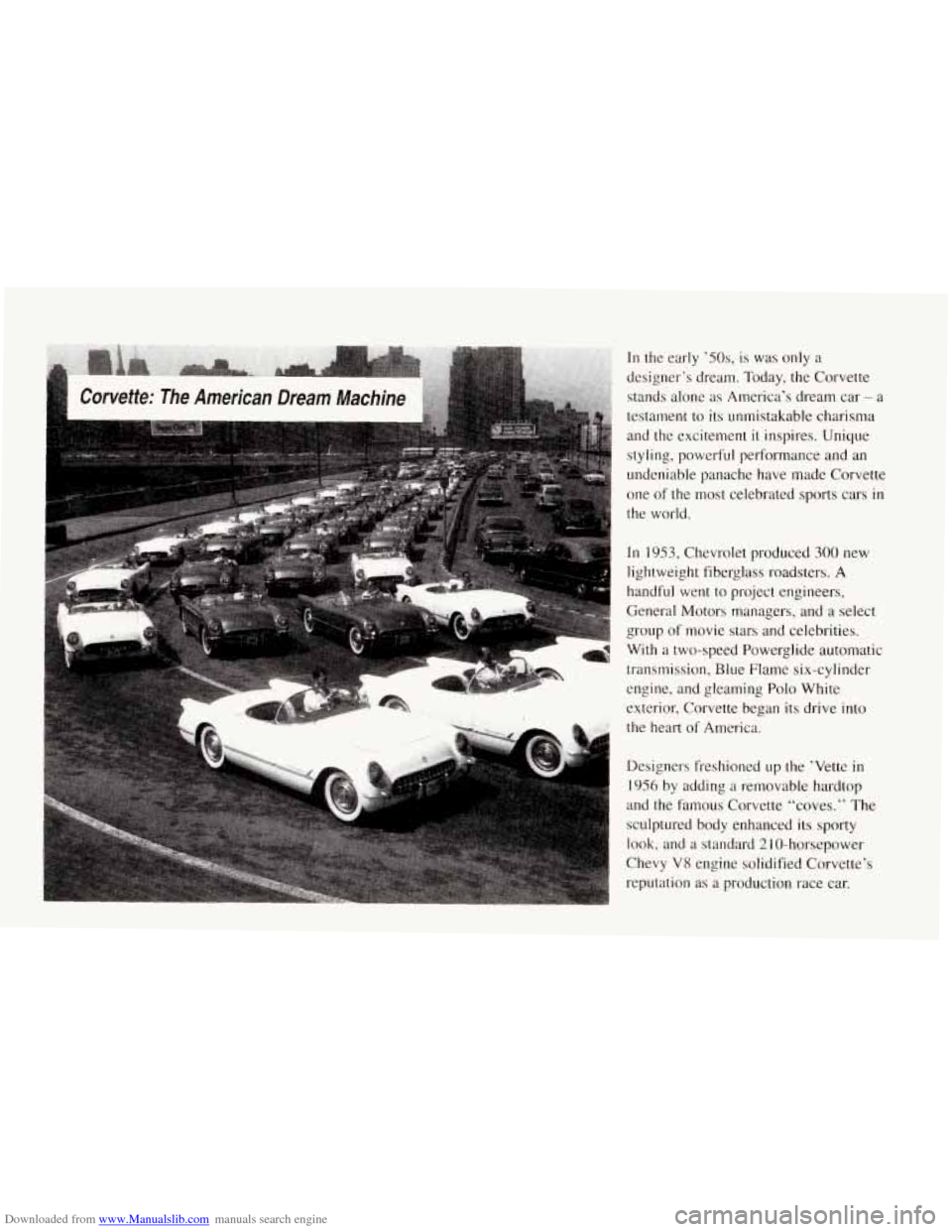
Downloaded from www.Manualslib.com manuals search engine In the early ’50s, is was only a
designer’s dream. Today, the Corvette
stands alone as America’s dream car
- a
testament to its unmistakable charisma
and the excitement it inspires. Unique
styling, powerful performance and an undeniable panache have made Corvette
one of the most celebrated sports cars
in
the world.
In 1953, Chevrolet produced 300 new
lightweight fiberglass roadsters.
A
handful went to project engineers,
General Motors managers, and a select
group of movie stars and celebrities.
With a two-speed Powerglide automatic
transmission, Blue Flame six-cylinder
engine, and gleaming Polo White
exterior, Corvette began its drive into
the heart
of America.
Designers freshioned up the ’Vette in
1956 by adding a removable hardtop
and the famous Corvette “coves.” The
sculptured body enhanced its sporty
look, and a standard 2 10-horsepower
Chevy
V8 engine solidified Corvette’s
reputation as a production race car.
Page 59 of 274
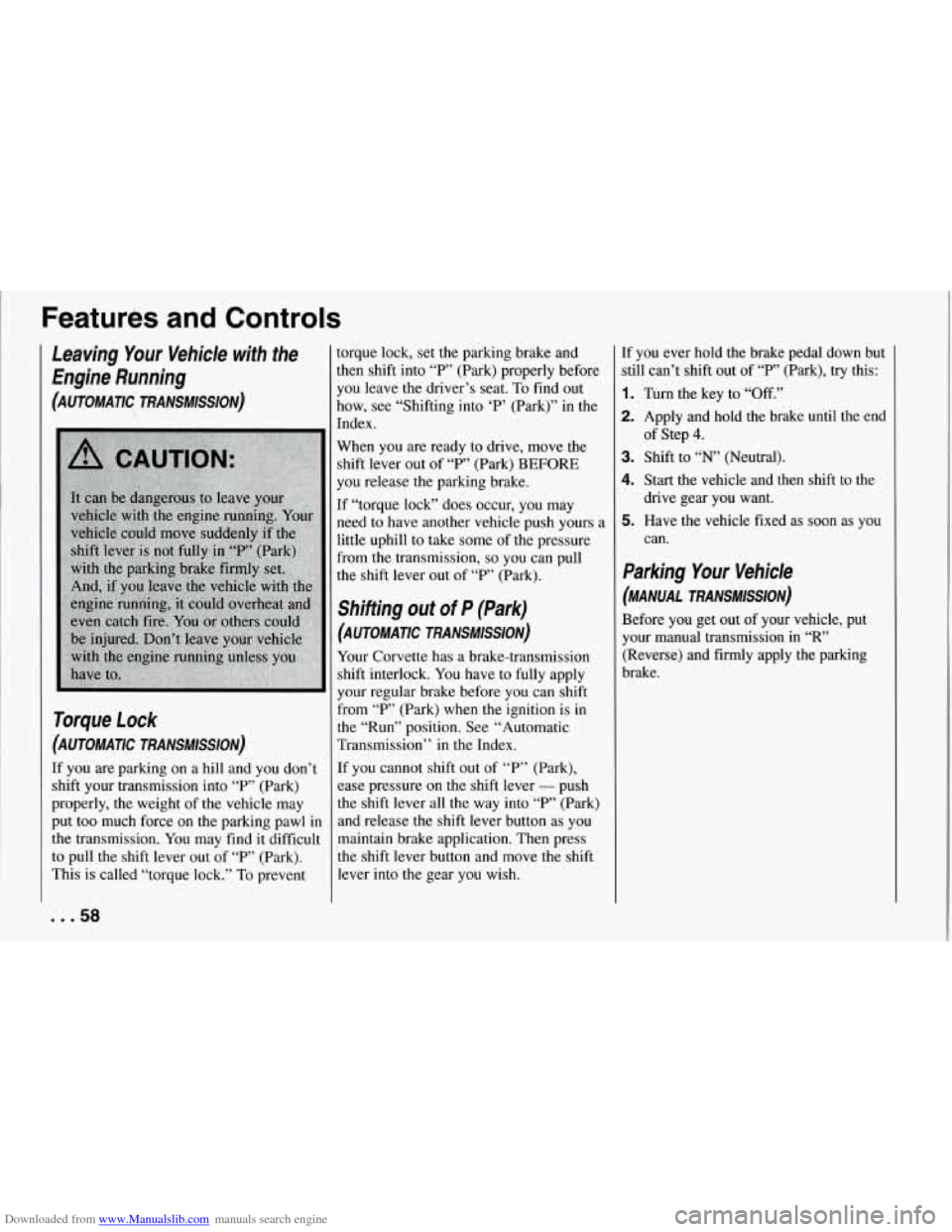
Downloaded from www.Manualslib.com manuals search engine Features and Controls
Leaving Your Vehicle with the
Engine Running
(AUTOMATIC TRANSMISSION)
Torque Lock
(AUTOMATIC TRANSMISSION)
If you are parking on a hill and you don’t
shift your transmission into
“P” (Park)
properly, the weight of the vehicle may
put too much force on the parking pawl in
the transmission. You may find it difficult
to pull the shift lever out of
“P’ (Park).
This is called “torque lock.” To prevent torque lock,
set the parking brake and
then shift into
“F’” (Park) properly before
you leave the driver’s seat.
To find out
how, see “Shifting into ‘P’ (Park)” in the
Index.
When you are ready to drive, move the
shift lever out of
“P” (Park) BEFORE
you release the parking brake.
If “torque lock” does occur, you may
need to have another vehicle push yours a
little uphill to take some of the pressure
from the transmission,
so you can pull
the shift lever out of
“P” (Park).
Shifting out of P (Park)
(AUTOMATIC TRANSMISSION)
Your Corvette has a brake-transmission
shift interlock. You have to fully apply
your regular brake before you can shift
from
“P” (Park) when the ignition is in
the “Run” position. See “Automatic
Transmission” in the Index.
If you cannot shift out of “P” (Park),
ease pressure on the shift lever
- push
the shift lever all the way into
“P” (Park)
and release
the shift lever button as you
maintain brake application. Then press
the shift lever button and move the shift
lever into the gear you wish. If you
ever hold the brake pedal down but
still can’t shift out of
“P” (Park), try this:
1. Turn the key to “Off.”
2. Apply and hold the brake until the end
3. Shift to “N’ (Neutral).
4. Start the vehicle and then shift to the
drive gear you want.
can. of Step
4.
5. Have the vehicle fixed as soon as you
Parking Your Vehicle
(MANUAL TRANSMISSION)
Before you get out of your vehicle, put
your manual transmission
in “R”
(Reverse) and firmly apply the parking
brake.
... 58
Page 97 of 274
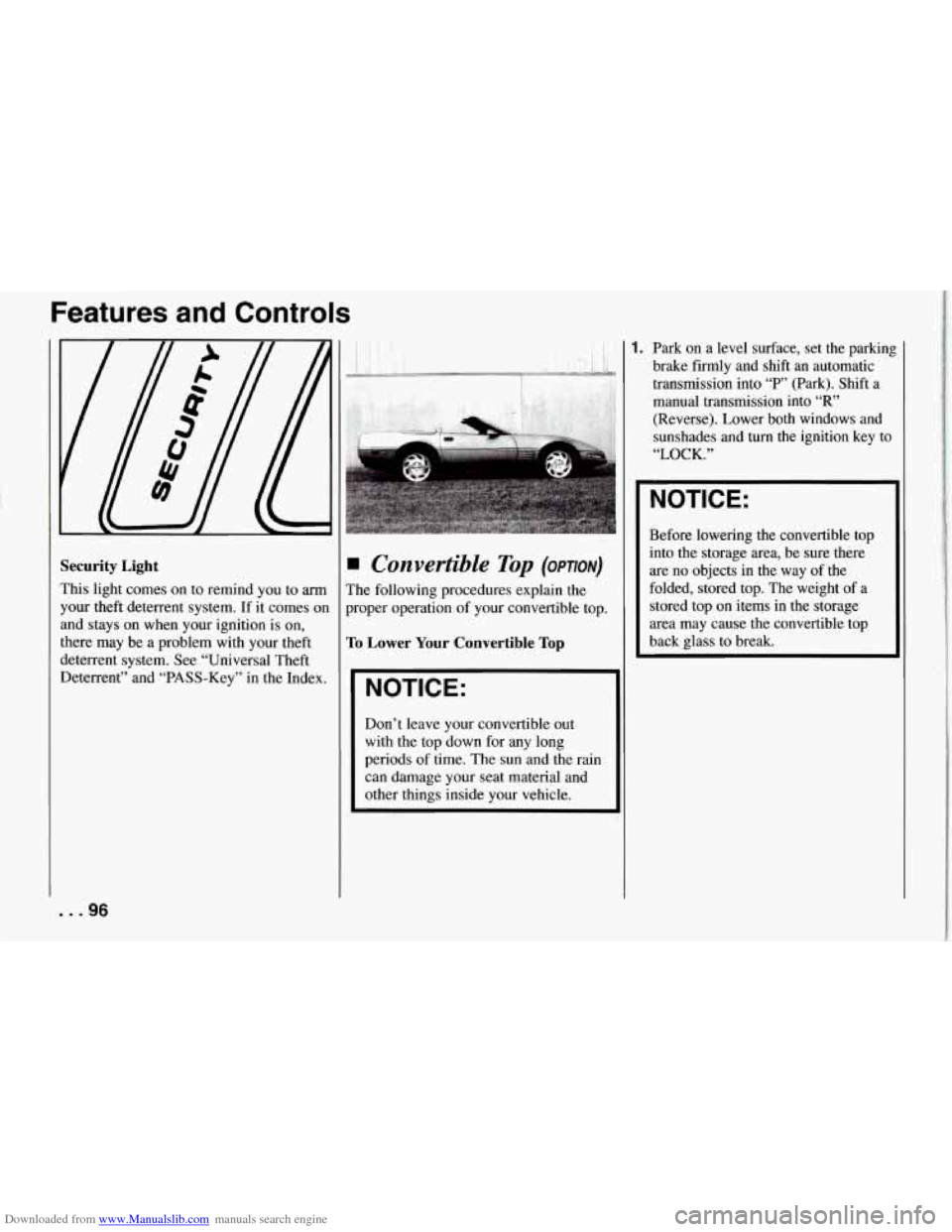
Downloaded from www.Manualslib.com manuals search engine Features and Controls
Security Light
This light comes on to remind you to arm
your theft deterrent system. If it comes on
and stays on when your ignition is on,
there may be a problem with your theft
deterrent system. See “Universal Theft
Deterrent” and “PASS-Key” in the Index.
Convertible Top (OPTION)
The following procedures explain the
proper operation of your convertible top.
To Lower Your Convertible Top
NOTICE:
~~
Don’t leave your convertible out
with the top down for any long
periods
of time. The sun and the rain
can damage your seat material and
other things inside your vehicle.
1. Park on a level surface, set the parkin8
brake firmly and shift an automatic
transmission into
“P’ (Park). Shift a
manual transmission into
“R”
(Reverse). Lower both windows and
sunshades and
turn the ignition key to
“LOCK.”
NOTICE:
Before lowering the convertible top
into the storage area, be sure there
are
no objects in the way of the
folded, stored top. The weight of a
stored top
on items in the storage
area may cause the convertible top
back glass to break.
... 96
Page 123 of 274
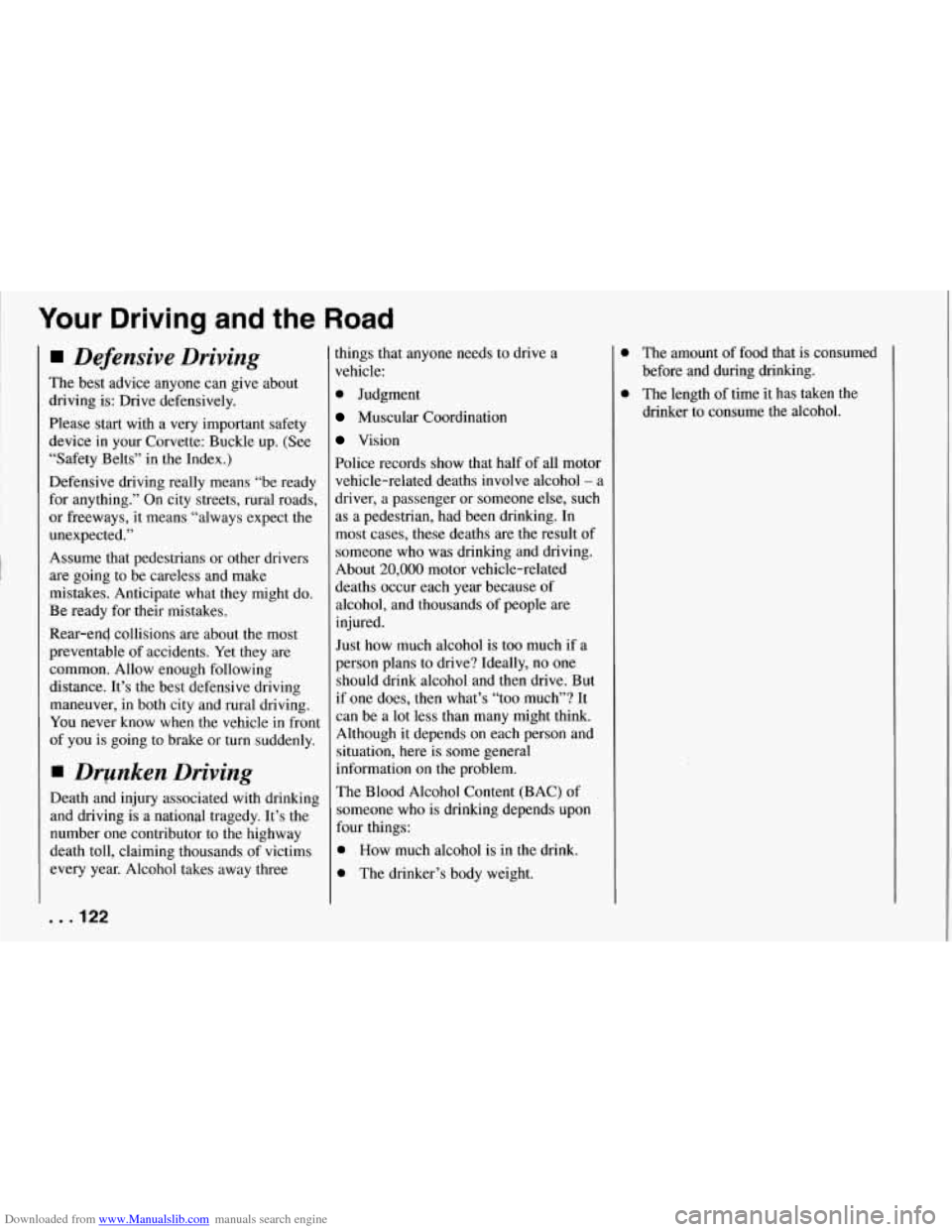
Downloaded from www.Manualslib.com manuals search engine I Your Driving and the Road
Defensive Driving
The best advice anyone can give about
driving is: Drive defensively.
Please start with a very important safety
device in your Corvette: Buckle up. (See
“Safety Belts” in the Index.)
Defensive driving really means “be ready
for anything.” On city streets, rural roads,
or freeways, it means “always expect the
unexpected.’’
Assume that pedestrians or other drivers
are going to be careless and make
mistakes. Anticipate what they might do.
Be ready for their mistakes.
Rear-en4 collisions are about
the most
preventable of accidents. Yet they are
common. Allow enough following
distance. It’s the best defensive driving
maneuver, in both city and rural driving.
You never know when the vehicle
in front
of you is going to brake or turn suddenly.
Drpnken Driving
Death and injury associated with drinking
and driving is a natioqal tragedy. It’s the
number one contributor to the highway
death toll, claiming thousands of victims
every year. Alcohol takes away three
. .I22
things that anyone needs to drive a
vehicle:
0 Judgment
Muscular Coordination
Vision
Police records show that half of all motor
vehicle-related deaths involve alcohol
- a
driver, a passenger or someone else, such
as a pedestrian, had been drinking. In
most cases, these deaths are the result of
someone who was drinking and driving.
About
20,000 motor vehicle-related
deaths occur each year because of
alcohol, and thousands of people are
injured.
Just how much alcohol is too much if a
person plans to drive? Ideally,
no one
should drink alcohol and then drive. But
if one does, then what’s “too much”? It
can be a lot less than many might think.
Although it depends
on each person and
situation, here is some general
information on the problem.
The Blood Alcohol Content (BAC) of
someone who is drinking depends upon
four things:
0 How much alcohol is in the drink.
0 The drinker’s body weight.
0
0
The amount of food that is consumed
before and during drinking.
The length of time
it has taken the
drinker to consume the alcohol.
Page 124 of 274
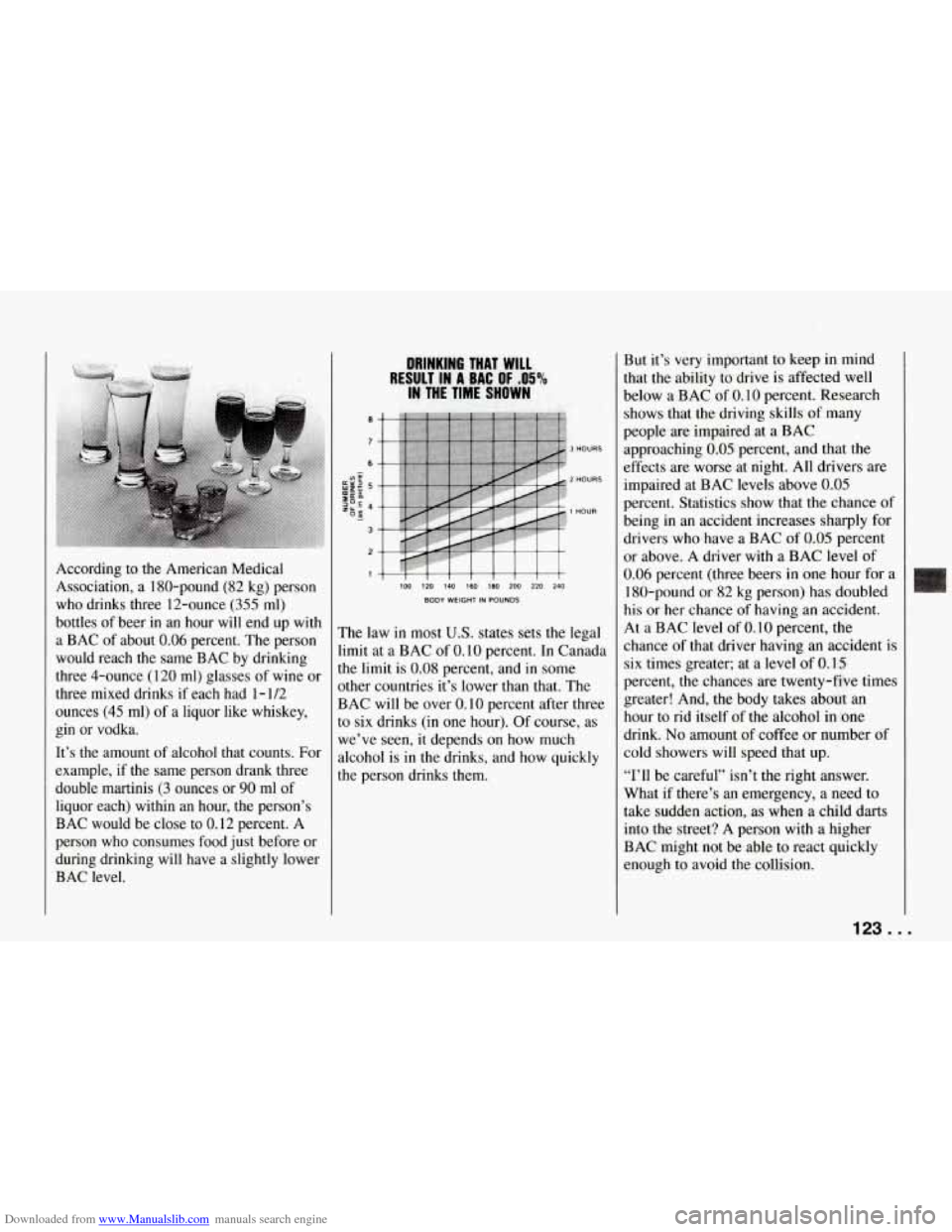
Downloaded from www.Manualslib.com manuals search engine According to the American Medical
Association, a 180-pound (82 kg) person
who drinks three 12-ounce (355 ml)
bottles
of beer in an hour will end up with
a BAC of about
0.06 percent. The person
would reach the same BAC by drinking
three 4-ounce (1 20
ml) glasses of wine or
three mixed drinks if each had 1
- 1/2
ounces (45 ml) of a liquor like whiskey,
gin or vodka.
It’s the amount of alcohol that counts. For
example, if
the same person drank three
double martinis (3 ounces or
90 ml of
liquor each) within
an hour, the person’s
BAC would be close to 0.12 percent. A
person who consumes food just before or
during drinking will have
a slightly lower
BAC level.
DRIN’KING THAT WILL
IN THE TIME SHOWN
RESULT IN A BAC OF. .OS%
3 HOURS
2 HOURS
1 HOUR
111l1111 IW 120 140 160 1.30 m 220 240
BODY WEIGHT IN POUNDS
The law in most U.S. states sets the legal
limit at a BAC of 0.10 percent.
In Canada
the limit is
0.08 percent, and in some
other countries it’s lower than that. The
BAC will be over
0.10 percent after three
to six drinks (in one hour). Of course, as
we’ve seen, it depends on how much
alcohol is in the drinks, and how quickly
the person drinks them.
.,. c. .-’ .t
But it’s very important to keep in mind
that the ability to drive is affected well
below a BAC of 0.10 percent. Research
shows that the driving skills
of many
people ai-e impaired at a BAC
approaching
0.05 percent, and that the
effects are worse at night. All drivers are
impaired at BAC levels above
0.05
percent. Statistics show that the chance of
being in an accident increases sharply for
drivers who have a BAC of
0.05 percent
or above. A driver with a BAC level of
0.06 percent (three beers in one hour for a
180-pound or 82 kg person) has doubled
his or her chance of having an accident.
At a BAC level of 0.10 percent, the
chance of that driver having an accident is
six times greater; at a level of
0.15.
percent, the chances are twenty-five times
greater! And, the body takes about an
hour to rid itself
of the alcohol in :one
drink.
No amount of coffee or number of
cold showers will speed that
up.
“I’ll be careful” isn’t the right answer.
What if there’s
an emergency, a need to
take sudden action, as when a child darts
into the street? A person with a higher
BAC might not be able to react quickly
enough to avoid the collision.
123 ...
Page 203 of 274
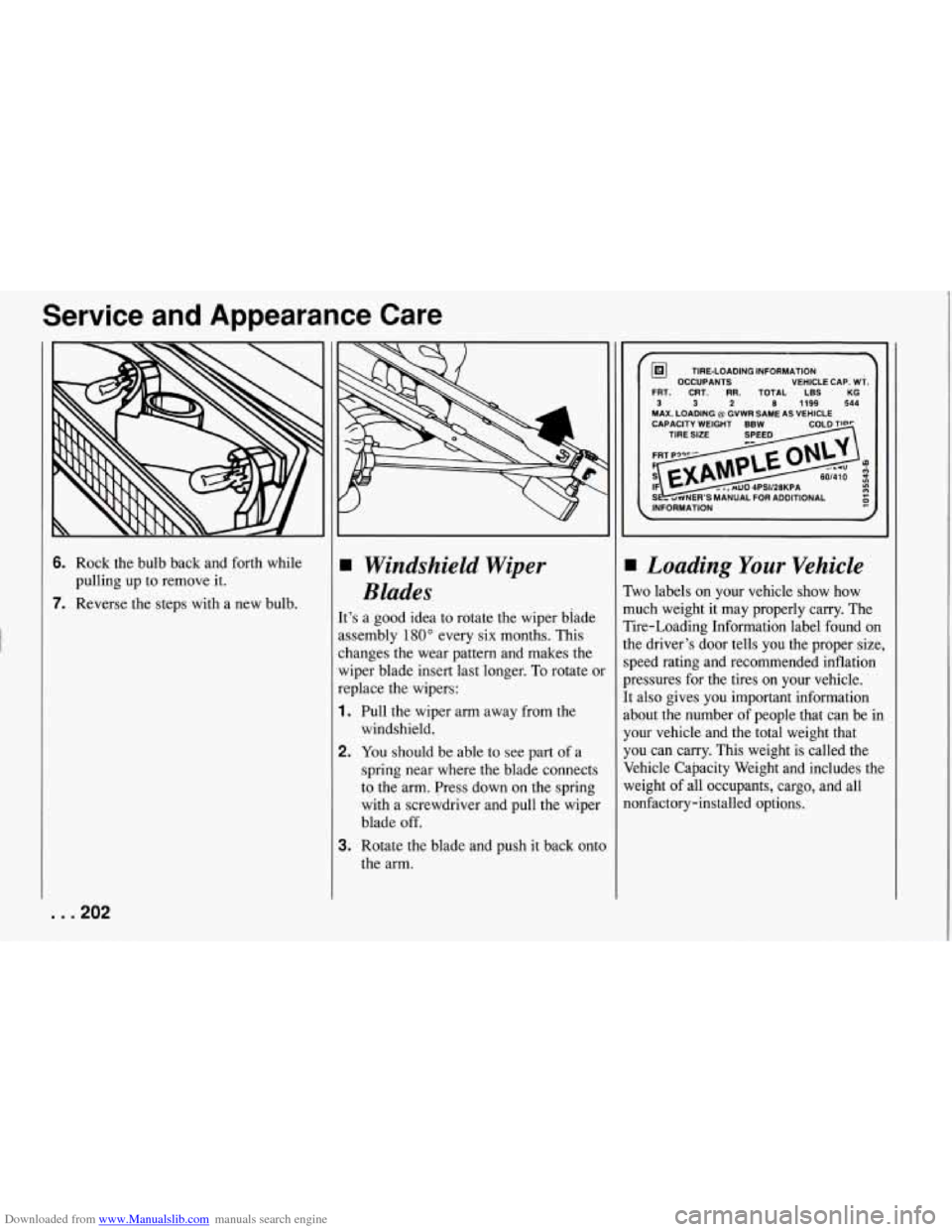
Downloaded from www.Manualslib.com manuals search engine Service and Appearance Care
6. Rock the bulb back and forth while
pulling up to remove it.
7. Reverse the steps with a new bulb.
. . ,202
Windshield Wiper
Blades
It's a good idea to rotate the wiper blade
assembly
180" every six months. This
changes the wear pattern and makes the
wiper blade insert last longer.
To rotate 01
replace the wipers:
1.
2.
3.
Pull the wiper arm away from the
windshield.
You should be able to see part of a
spring near where the blade connects
to the arm. Press down on the spring
with a screwdriver and pull the wiper
blade
off.
Rotate the blade and push it back ontc
the arm.
TIRE-LOADING INFORMATION
FRT. CRT.
RR. TOTAL LBS KG 3 3 2 MAX. LOADING @ GVWR SAME AS VEHICLE a 1199 544
CAPACITY WEIGHT BBW OCCUPANTS VEHICLE CAP.
wi.
TIRE SIZE
60/410
3 9
INFORMATION 0 F
/
I Loading Your Vehicle
Two labels on your vehicle show how
nuch weight it may properly carry. The
rire-Loading Information label found on
he driver's door tells you the proper size,
'peed rating and recommended inflation
n-essures for the tires on your vehicle.
t also gives you important information
ibout the number
of people that can be in
Tour vehicle and the total weight that
TOU can carry. This weight is called the
iehicle Cabacity Weight and includes the
weight of all occupants, cargo, and all
lonfactory-installed options.
Page 204 of 274
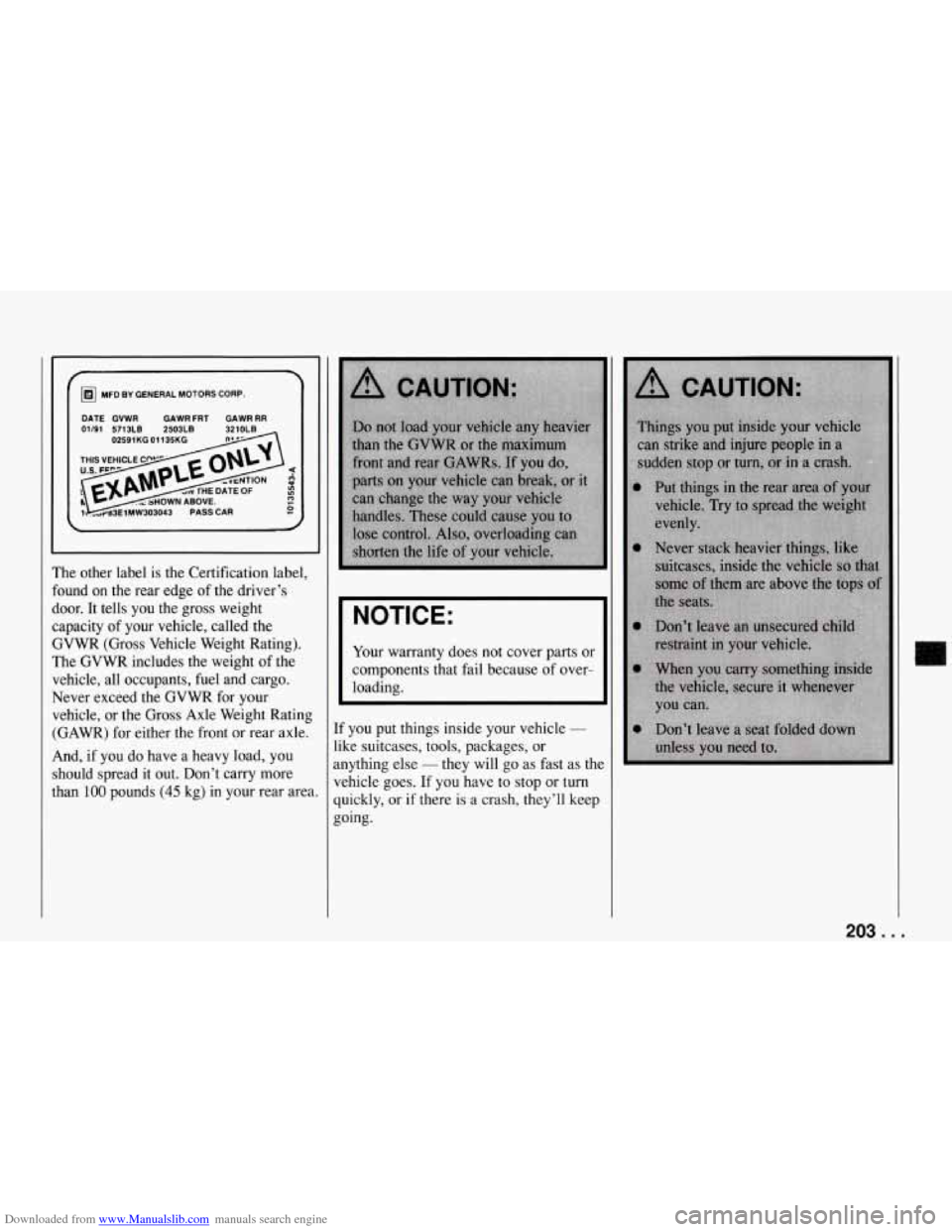
Downloaded from www.Manualslib.com manuals search engine MFD BY GENERAL MOTORS CORP.
01/91 5713LB 2503LB DATE GVWR
GAWRFRT GAWRRR
The other label is the Certification label,
found on the rear edge of the driver’s
door. It tells you the gross weight
capacity of your vehicle, called the
GVWR (Gross Vehicle Weight Rating).
The GVWR includes the weight of the
vehicle, all occupants,
fuel and cargo.
Never exceed
the GVWR for your
vehicle, or the Gross Axle Weight Rating
(GAWR) for either the front or rear axle.
And, if you do have a heavy load, you
should spread it out. Don’t carry more
than
100 pounds (45 kg) in your rear area.
I NOTICE:
I
Your warranty does not cover parts or
components that fail because of over-
loading.
~~
If you put things inside your vehicle -
like suitcases, tools, packages, or
anything else
- they will go as fast as the
vehicle goes. If you have to stop or
turn
quickly, or if there is a crash, they’ll keep
going.
203. . .